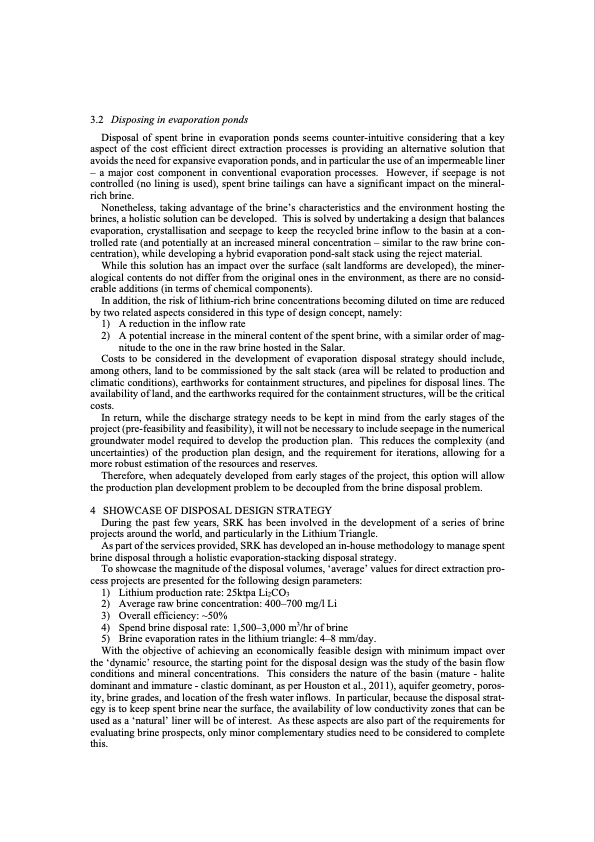
PDF Publication Title:
Text from PDF Page: 005
3.2 Disposing in evaporation ponds Disposal of spent brine in evaporation ponds seems counter-intuitive considering that a key aspect of the cost efficient direct extraction processes is providing an alternative solution that avoids the need for expansive evaporation ponds, and in particular the use of an impermeable liner – a major cost component in conventional evaporation processes. However, if seepage is not controlled (no lining is used), spent brine tailings can have a significant impact on the mineral- rich brine. Nonetheless, taking advantage of the brine’s characteristics and the environment hosting the brines, a holistic solution can be developed. This is solved by undertaking a design that balances evaporation, crystallisation and seepage to keep the recycled brine inflow to the basin at a con- trolled rate (and potentially at an increased mineral concentration – similar to the raw brine con- centration), while developing a hybrid evaporation pond-salt stack using the reject material. While this solution has an impact over the surface (salt landforms are developed), the miner- alogical contents do not differ from the original ones in the environment, as there are no consid- erable additions (in terms of chemical components). In addition, the risk of lithium-rich brine concentrations becoming diluted on time are reduced by two related aspects considered in this type of design concept, namely: 1) A reduction in the inflow rate 2) A potential increase in the mineral content of the spent brine, with a similar order of mag- nitude to the one in the raw brine hosted in the Salar. Costs to be considered in the development of evaporation disposal strategy should include, among others, land to be commissioned by the salt stack (area will be related to production and climatic conditions), earthworks for containment structures, and pipelines for disposal lines. The availability of land, and the earthworks required for the containment structures, will be the critical costs. In return, while the discharge strategy needs to be kept in mind from the early stages of the project (pre-feasibility and feasibility), it will not be necessary to include seepage in the numerical groundwater model required to develop the production plan. This reduces the complexity (and uncertainties) of the production plan design, and the requirement for iterations, allowing for a more robust estimation of the resources and reserves. Therefore, when adequately developed from early stages of the project, this option will allow the production plan development problem to be decoupled from the brine disposal problem. 4 SHOWCASE OF DISPOSAL DESIGN STRATEGY During the past few years, SRK has been involved in the development of a series of brine projects around the world, and particularly in the Lithium Triangle. As part of the services provided, SRK has developed an in-house methodology to manage spent brine disposal through a holistic evaporation-stacking disposal strategy. To showcase the magnitude of the disposal volumes, ‘average’ values for direct extraction pro- cess projects are presented for the following design parameters: 1) Lithium production rate: 25ktpa Li2CO3 2) Average raw brine concentration: 400–700 mg/l Li 3) Overall efficiency: ~50% 4) Spend brine disposal rate: 1,500–3,000 m3/hr of brine 5) Brine evaporation rates in the lithium triangle: 4–8 mm/day. With the objective of achieving an economically feasible design with minimum impact over the ‘dynamic’ resource, the starting point for the disposal design was the study of the basin flow conditions and mineral concentrations. This considers the nature of the basin (mature - halite dominant and immature - clastic dominant, as per Houston et al., 2011), aquifer geometry, poros- ity, brine grades, and location of the fresh water inflows. In particular, because the disposal strat- egy is to keep spent brine near the surface, the availability of low conductivity zones that can be used as a ‘natural’ liner will be of interest. As these aspects are also part of the requirements for evaluating brine prospects, only minor complementary studies need to be considered to complete this.PDF Image | Direct extraction lithium processes

PDF Search Title:
Direct extraction lithium processesOriginal File Name Searched:
Ezama-Hoyos-Cortegoso-Braun-Spent_Brine_Disposal-TMW_Paper20191128190251287.pdfDIY PDF Search: Google It | Yahoo | Bing
Product and Development Focus for Infinity Turbine
ORC Waste Heat Turbine and ORC System Build Plans: All turbine plans are $10,000 each. This allows you to build a system and then consider licensing for production after you have completed and tested a unit.Redox Flow Battery Technology: With the advent of the new USA tax credits for producing and selling batteries ($35/kW) we are focussing on a simple flow battery using shipping containers as the modular electrolyte storage units with tax credits up to $140,000 per system. Our main focus is on the salt battery. This battery can be used for both thermal and electrical storage applications. We call it the Cogeneration Battery or Cogen Battery. One project is converting salt (brine) based water conditioners to simultaneously produce power. In addition, there are many opportunities to extract Lithium from brine (salt lakes, groundwater, and producer water).Salt water or brine are huge sources for lithium. Most of the worlds lithium is acquired from a brine source. It's even in seawater in a low concentration. Brine is also a byproduct of huge powerplants, which can now use that as an electrolyte and a huge flow battery (which allows storage at the source).We welcome any business and equipment inquiries, as well as licensing our turbines for manufacturing.| CONTACT TEL: 608-238-6001 Email: greg@infinityturbine.com | RSS | AMP |